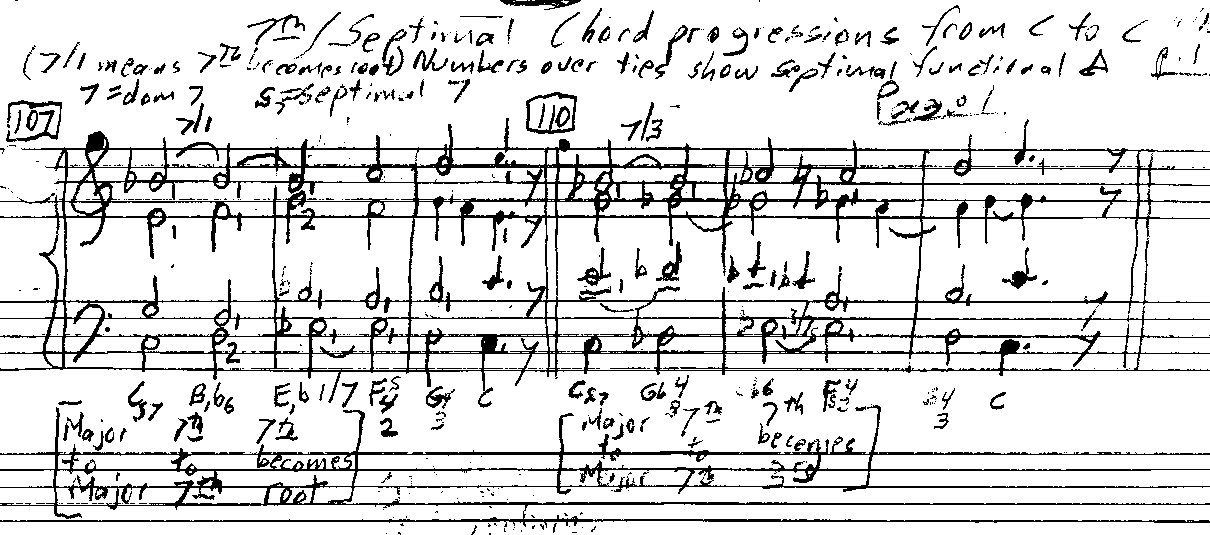Seventh harmonic chord progressions: The New Consonance
As I have said before, by 1900 there was a sense that all of the musical territory of traditional tonality had been discovered. There were no new sonic continents to explore. With the seventh harmoinic chord progressions In this chapter, you will find more new realms of tonality than have been discovered in all of the tonal-based explorations of the last 100 years combined. We catapault from reviving the ancient sonic purity into what I consider one of the most important new directions for the future of tonal music. Septimal harmony has been explored by a few brilliant microtonalists, but as yet has not gotten much traction in the larger musical world. I hereby christen the new musical continent Septimus (Latin for born seventh)!
Chord progressions employing the seventh harmonic as a pivot can follow all the rules of traditional voicing. And they present some amazing sonic possibilities. Because the natural 7th harmonic is 39 cents flat from the 12-eq minor seventh, when you get into true septimal harmony, you hear 39-cent microtonal shifts all over the place. A few new rules come into play to account for microtonal voicing. But all the old basic rules, as well as a proposed set of new rules for microtonal voicing, have already been covered in Chapter 11.
With this, we can really bring traditional tonality into the future. In 12-eq, you have the choice of either making your music more and more dissonant or keeping it simple enough not to bump against 12-eq’s inherent tendency to pile on dissonance as you add complexity.
In 53-eq, you can evoke the ancient scales with incredible accuracy. With a little tweaking, you can work with the complex harmonic language of the Late Romantics (Mahler, Strauss, Busoni, Scriabin, etc). You can even rearrange their music into 53-eq (with some serious musical translating along the way) and make the music sound less biting and harsh while maintaining its complexity. And, you can create music of the 21st century as you explore the almost virgin territory of the seventh harmonic. These chord progressions are new to our ears, and they are beautiful. They sound consonant because they are consonant. They allow for entirely new harmonic journeys into soundscapes no one has ever heard before. They evoke a whole new palette of responses in the listener. I can spend the rest of my life exploring the expressive possibilities of septimal harmony and barely scratch the surface. We don’t even know what kinds of emotional and spiritual journeys are possible with these new harmonies.
My first composition which extensively uses seventh-harmonic chord progressions and septimal modulations was purposely kept as simple as possible, with chord progressions that quickly return you to the tonic, and very few suspensions or attempts to “mask” the chordal structure. Over and over, I employ the traditional dominant seventh-tonic progression to quickly bring the music back to the home key of Eb. Twentieth century tonal music often masks the chords with minor ninths, major sevenths and the like, but my composition draws out the chords and allows you to really hear them. Maybe in a few generations, composers will want to “mask” septimal harmonies. But for now, I am following Wagner’s choice: when he discovered new harmonic territory, he often drastically slowed the music down and gave our ears a chance to revel in the beauty of it all (if you know the moment Brunnhilde is awakened by Siegfried’s kiss, you know what I mean). We’ll get to my song “St. Francis and the Sow” at the end of this chapter, but for now let’s listen to a good-sized collection of septimal chord progressions. Because they all follow the voicing rules of common-practice classical music, they can now be fully integrated into the Western classical tradition. These are the barest, purest, simplest voicing exercises, and even these have incredible expressive power to my ear…
For this sample page I am going to go directly to some of the most beautiful septimal chord progressions. These are only two of dozens of septimal chord progressions on this page. To me, this is the most exciting and revelatory chapter of my entire book; these chord progressions do more to expand traditional tonality than anything else I have seen in the entire twentieth and twenty-first centuries.
The examples below show a 4-part, SATB, ultra-conservative chord progression. Wherever you see two numbers like 7/1 or 1/7 or 5/7, it means the first number becomes the second number in the progression. For example, in the very first measure, the soprano is singing a B1b, which is the septimal seventh of the C chord we are starting on. That seventh B1b is held over and becomes a “first,” or tonic, of the next chord. In the second measure, we see a 1/7, which is to say that the “first” or tonic E1b of the chord becomes the 7th of the F septimal chord that follows. The words “Major to Major” means that we start with a Major affect (the C sep 7 chord with an E-natural in the chord) and move to another Major-affect realm (the B1b sep 7 chord). The “7th – 7th,” or sometimes, “7th-in, 7th-out” means that the movement chordally is all by sevenths. Sometimes you’ll see “7th-out, ga-ga in,” which would mean that you depart chordally by a septimal seventh and return via 5-limit chord movement, where the septimal interval becomes the enharmonic equivalent of a ga-ga interval. The terms “7th becomes root” or “7th becomes 3rd” etc. simply tell us that the seventh in the first chord, when held over, becomes the root of the next chord. This is the same as any regular old-fashioned chord progression. For example, if you travel from C Major to F Major and hold over the C, you could write 1/5, meaning the C (1″) becomes the 5th of the F Major chord that follows it. In old-fashioned chord progressions, such notation is so obvious as to be unnecessary, but I have found it to be extremely helpful in septimal harmony!
We are going to talk first about the simplest septimal progressions (above), where the septimal seventh note becomes the root or third of the next chord. In our first example (measure 107), the B1b is the seventh of C. It’s sounded in the soprano part and held over to become the root of a B1b Major chord. Then we move a fifth to E1b Major. This gives us a moment of “grounding” in the new harmonic realm. That’s helpful, because as I said before, the transition from a C septimal seventh chord to a B1b chord means microtonal pitch shifts in three of the four notes. From the E1b chord, we transition back towards C. The root of the E1b chord becomes the septimal seventh of the F septimal seventh chord. From there, we go to a regular G7 chord and back to C. Stepwise progressions are very helpful, which is why I created a walking bass line using a few inversions. The harmonic movement in septimal transitions is so new and big, I try to make everything else as smooth as possible….
With dozens more never-before-heard septimal chord progressions (at least not as fully organized as this), this is the single biggest and most important section of my entire e-book. If you would like to learn more about this chapter, “Seventh Harmonic Chord Progressions: The New Consonance,” you can buy the entire book, The Grand Unified Theory of Music, in pdf form for $25 with hundreds of embedded musical examples of scales and chord progressions from all over the world.
A free introduction to what The Grand Unified Theory of Music offers is on this website and includes both text and a few musical examples from each webpage. If you would like to learn more about this chapter and the full contents of this entire e-book, you can buy The Grand Unified Theory of Music for $25, with hundreds of embedded musical examples of scales and chords from all over the world — and ideas for how to set up your computer system —
HERE.
You’ll get a personalized password you can use to see the entire e-book. Inside the full book, you will also get a link to the complete pdf file of this e-book, which you can read on your Kindle or similar device. The links to the hundreds of mp3 sound files – the same ones you can hear on the website — will also be included. This is “Version 1.0” of The Grand Unified Theory of Music. Because it is an e-book, additions, corrections and improvements in the sound may be added at any time. The Grand Unified Theory of Music is Copyright © 2018 by Christopher Mohr. All rights reserved.
One person per password. Sharing this password with others is a violation of copyright. Do not allow others to use your password or link to the pdf file!

